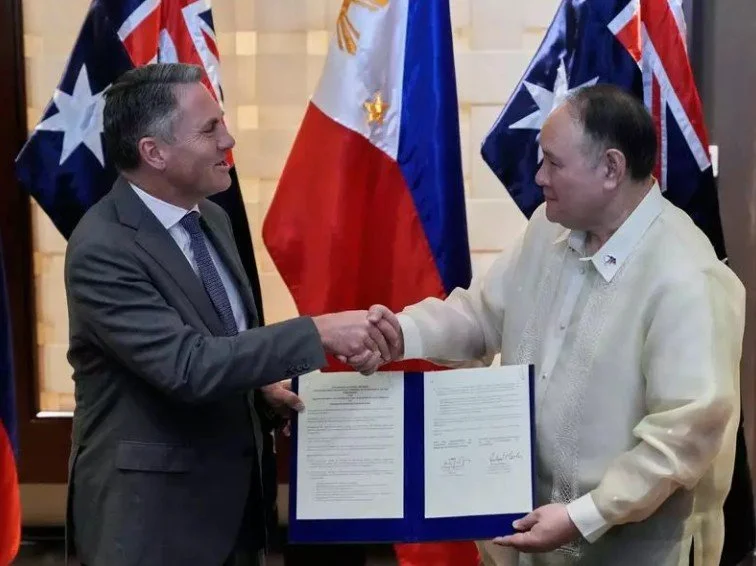Philippines–Australia New Defence Pact Emerges as a Southern Node in ASEAN Security
The Philippines and Australia will sign a defence pact in 2026 covering joint military drills and eight new infrastructure projects at five Philippine sites. The agreement, intended to boost combined operational capability and regional deterrence, is arguably emerging as a potential ‘southern node’ in Indo-Pacific security architecture. By complementing existing northern hubs such as U.S. alliances with Japan, South Korea, and Taiwan, and western hubs shaped by India’s presence in the Bay of Bengal, this pact raises eyebrows over how it might redefine ASEAN’s decentralized security landscape.
Manila’s maritime friction with Beijing has only intensified in recent years. China continues to assert its sweeping claim over nearly the entire South China Sea, openly defying the 2016 Hague tribunal ruling that invalidated those claims. During 2025 itself, Chinese forces staged a series of dangerous confrontations: a helicopter flew within meters of a Philippine patrol plane, militia vessels inflicted millions in reef damage near Pag-asa, PLA Navy spy ships intruded into the Philippine EEZ, and coast guard clashes erupted near Scarborough Shoal. Each clash showed how far Beijing’s readiness to escalate goes and how firm Manila’s determination is to push back.
Since President Marcos Jr. took office in 2022, Manila has condemned what it calls China’s expansionist behavior and accelerated military modernization and expanded its security partnerships well beyond the traditional U.S. alliance. The Philippines signed a landmark Reciprocal Access Agreement with Japan in July 2022, the first in Asia, allowing easier movement of troops and equipment for drills and humanitarian missions. Alongside this, Australia has also drawn closer, casting Southeast Asia as a strategic priority and affirming that ASEAN’s security is Australia’s security, explicitly pledging to safeguard regional sea lanes and respond to shared threats. The upcoming Manila–Canberra agreement, therefore, fits a wider trend as ASEAN states forge multi-directional security ties rather than anchoring on any single alliance.
The Indo-Pacific security order is taking shape as a latticework of interlocking partnerships rather than a single alliance system. The U.S.–Japan–South Korea framework anchors deterrence in Northeast Asia, while India’s naval presence in the Andaman Islands secures the Bay of Bengal and Indian Ocean. The Philippines–Australia pact now provides a southern anchor, linking Luzon and Palawan to Australian forces in the Pacific. Together, these hubs connect Southeast Asia and the Pacific into a defence grid that strengthens the region’s southern flank.
By adding a new hub, the pact pushes regional security toward a decentralized, flexible model. Instead of relying on a single alliance, ASEAN states can connect to whichever node matches their immediate needs. Minilateral groups are already forming for this purpose, such as the U.S.–Japan–Australia–Philippines “Squad” on South China Sea patrols. Now the southern node follows the same logic, focusing on sea lanes and deterrence in maritime Southeast Asia. Likewise, this offers Vietnam a direct line to Australia and the Philippines without binding all of ASEAN to one position. For Malaysia and Singapore, already tied to Canberra through the Five Power Defence Arrangements (FPDA), the pact sharpens FPDA’s relevance by projecting its strategic weight deeper into contested waters.
Critics might argue that the creation of a southern node through the Philippines–Australia deal risks widening ASEAN’s internal divides. Some members, such as the Philippines, Singapore, and Vietnam, are comfortable deepening ties with extra-regional powers, while others like Laos, Cambodia, and, to some extent, Thailand, remain wary of entanglement or provoking China. Beijing has already denounced such arrangements as “small circles,” and closer Philippine–Australian defence ties could invite sharper Chinese pushback.
A decentralized security model of the southern node, however, gives ASEAN states far greater room to maneuver, with countries can expand deterrence options by working with multiple partners on their own terms. Frontline states such as the Philippines, Vietnam, Malaysia, and Indonesia gain an added layer of security through Australian cooperation in monitoring contested waters and responding to incidents. Over time, a lattice of nodes, each contributing niche strength, allows open networks for ASEAN to join as needed, sustaining dialogue while strengthening deterrence.
The forthcoming Philippines–Australia deal is an unmistakable signal to China that attempts to dominate the South China Sea will encounter coordinated resistance. This shift has surely direct implications for ASEAN security, which heightens the risk of sharper Chinese reactions. Thus, ASEAN states must prepare for a security environment where external powers are more deeply embedded in the region, while remaining careful to preserve channels of dialogue with Beijing.
ASEAN should treat the Manila–Canberra arrangement as a complementary element of regional defence, not a threat to its centrality. If managed well, this southern node can eventually reinforce, not fragment, Southeast Asia’s security architecture. The coming years will test ASEAN’s adaptability, whether it can leverage these overlapping nodes for common benefit or find itself sidelined by great-power networks.
Geo Dzakwan Arshali is an undergraduate student in International Affairs Management at the School of International Studies, Universiti Utara Malaysia, and Emerging Scholar of the Indo-Pacific Studies Center. He is concurrently a Cadet Researcher at the Asian Institute of International Affairs and Diplomacy (AIIAD) and a Senior Analyst & Program Manager at World Order Lab. His research interests center on Southeast Asia, especially Indonesia, Malaysia, and the Philippines, with a focus on domestic politics and regional security affairs, as well as the broader Indo Pacific security architecture


